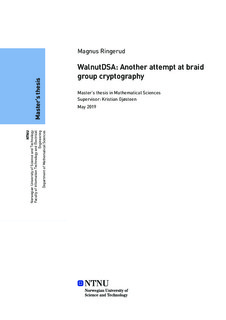| dc.contributor.advisor | Gjøsteen, Kristian | |
| dc.contributor.author | Ringerud, Magnus | |
| dc.date.accessioned | 2019-10-17T14:00:17Z | |
| dc.date.available | 2019-10-17T14:00:17Z | |
| dc.date.issued | 2019 | |
| dc.identifier.uri | http://hdl.handle.net/11250/2622842 | |
| dc.description.abstract | Hovedformålet med denne oppgaven er å studere det digitale signatursystemet WalnutDSA, som ble foreslått til det amerikanske National Institute of Standards and Technology (NIST) sin ``Post-Quantum Cryptography Standardization'' prosess. For å forstå systemet er ett kapittel satt av til å utlede den nødvendige teorien for flettegrupper. Vi ser raskt på noen eldre kryptosystemer som involverer flettegrupper, og hvorfor de er usikre. Etter å ha presentert Walnut-systemet ser vi på forskjellige angrep konstruert for å knekke det, før vi gir noen kommentarer som kan forklare hvorfor NIST valgte å ikke inkludere systemet i runde to av standardiseringsprosessen. | |
| dc.description.abstract | The main purpose of this thesis is to study the WalnutDSA digital signature scheme proposed for the American National Institute of Standards and Technology's (NIST) Post-Quantum Cryptography Standardization process. In order to understand the scheme, one chapter is devoted to develop the necessary theory for braid groups. We then briefly look into some of the older schemes involving braid groups, and why they are insecure. After presenting the Walnut scheme, we study attacks designed to break it, before giving comments which may explain why NIST chose not to include the scheme in the second round of the standardization process. | |
| dc.language | eng | |
| dc.publisher | NTNU | |
| dc.title | WalnutDSA: Another attempt at braid group cryptography | |
| dc.type | Master thesis | |
